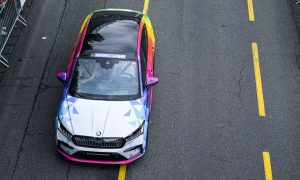
As part of final test drives, the Volkswagen brand is announcing the first details of its currently best-selling model: The third generation of the new Tiguan will be available with a newly developed active suspension control system and full-size features such as HD Matrix headlights. It is based on the new generation of the modular transverse matrix, MQB evo. With plug-in hybrid drive, the new Tiguan will achieve electric ranges of up to 100 kilometres in the future. The world premiere will take place in autumn, and the bestseller will be launched on the market in 2024.
The Tiguan has been the Volkswagen brand’s best-selling model worldwide for years. Since its debut in autumn 2007, more than 7.4 million people around the world have chosen this SUV. Now Volkswagen is completely relaunching the successful model.
Volkswagen has further developed the modular transverse matrix for the new Tiguan. The new generation is called MQB evo. Kai Grünitz, Member of the Brand Board of Management responsible for Technical Development: “State-of-the-art technology components interact perfectly in the MQB evo: a new generation of plug-in hybrid drives with electric ranges of up to 100 kilometres, probably the best active chassis control in its segment, premium interior quality and an equally new and intuitive infotainment system deliver what drivers expect from Volkswagen.”
Some new features at a glance
IQ.LIGHT HD matrix headlights. The Tiguan will be one of the first vehicles in its class to be available with optional HD matrix headlights. The IQ.LIGHT HD matrix headlight technology was developed jointly for the Tiguan and Touareg. Based on the top-down principle, the lighting technology of a premium-class model will now be used in the mid-sized Tiguan.
New display- and operating concept. The interior of the Tiguan has been revamped and designed. Volkswagen has taken specific customer requirements into account for intuitive operation. For example, the Tiguan comes onto the market with a newly developed cockpit and a new infotainment system. A screen with a diagonal of up to 38 centimetres (15 inches) clearly displays important functions such as navigation, music and climate control and can be customised with quick access. The center console also houses the Driving Experience Control. The rotary control with its own mini-screen can be used to control drive mode, radio volume or ambient lighting colours. High-quality materials, newly developed seats and effective noise insulation increase value and comfort. In particular, in conjunction with a new “acoustic package” (optional), the Tiguan is designed to provide premium-class noise comfort. The centre consoles also offer more space for storage.
In future, the Tiguan will be offered exclusively with an automated shift gearbox (DSG). Like on the Volkswagen ID. models, the gear position is now changed by means of a steering column switch on the right of the steering wheel with a self-explanatory operating principle. The switch is turned forwards to “D” to drive forwards and backwards to “R” to reverse, while the parking brake is activated by pressing the side of the switch. In addition, paddle shifters are available behind the steering wheel.
Electronically controlled suspension for more comfort and dynamics. The MQB evo provides the starting point for a new generation of the adaptive suspension control DCC: the optional DCC Pro with two-valve shock absorbers. The new model is now additionally equipped as standard with a vehicle dynamics manager – an MQB system that made its debut in the current Golf GTI2. The system controls the functions of the electronic differential locks (XDS) and the lateral dynamics components of the controlled shock absorbers in the DCC Pro system. Thanks to the Vehicle Dynamics Manager, which performs wheel-specific braking interventions and wheel-selective adjustments of the shock absorber hardness, the handling characteristics are more neutral, stable, agile and precise. This progress will be noticeable on board through increased comfort as well as significantly improved performance in dynamic cornering.
TDI, TSI, eTSI and eHybrid. Thanks to MQB evo, different drive types are possible for the Tiguan. It will be offered with turbodiesel engines (TDI), turbocharged petrol engines (TSI), mild hybrid turbocharged petrol engines (eTSI) and plug-in hybrid systems (eHybrid). The electric range of the new plug-in hybrid drives has been increased to up to 100 kilometres compared with the predecessors, depending on equipment. In addition, AC charging will be faster in all eHybrid versions, and DC charging will also be possible as standard for the first time.
Premium-class seats. The Tiguan will be optionally available with ergoActive front seats. Among other things, these seats come with pneumatic four-way lumbar support adjustment and a pneumatic 10-chamber pressure point massage function in the backrests – features that are usually found in premium-class models. They are also equipped with seat heating and ventilation.
Larger luggage compartment in the Tiguan. The new Tiguan grows in length by around three centimetres. Height, width and wheelbase remain almost identical to the predecessor. The luggage compartment capacity of the new generation shows just how good the use of space is: although the SUV is only slightly longer, its luggage compartment capacity has increased by 33 litres to 648 litres (when loaded up to the height of the rear seat backrests).



